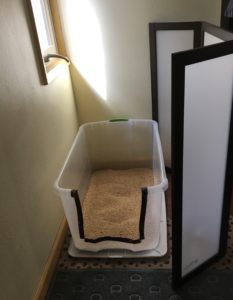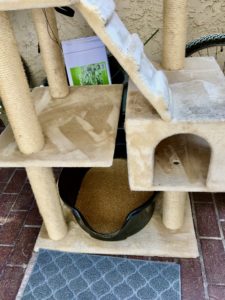Kitty litter has come a long way since Edward Lowe started marketing bentonite clay as a litter box filler in 1947. What options has high tech provided you and your cat?
More than just clay…
Litter boxes are being filled with lots of different materials these days. There are litters made from grass seed, corn, wheat, recycled wood, and coconut, to name just a few. So why all these other alternatives to the traditional clay litter?
A Look at Bentonite…
Clay cat litters are made from bentonite clay, named after Fort Benton, WY where the largest deposits of bentonite clay are found. Bentonite is a natural resource – it is formed after volcanic ash ages. It is strip mined, then processed for commercial use. Once it is used up, it is gone. Clumping clay cat litter is made from sodium bentonite, which absorbs water, swells and hardens into a clump.
Not Eco-friendly…
If you are looking for an eco-friendly cat litter, clay litters have some strikes against them:
- bentonite is not renewable
- strip mining for bentonite can cause environmental damage.
Eco-Friendly Litters…
Sourcing…
Plant-based litters are made from corn, wheat, wood, and even tofu by-products. Starch and plant fibers make these litters clump. These litters tend to be lighter and less dusty than clay litter.
- you can grow more plants to produce more litter.
- the growing and harvesting methods do not damage the environment as much as strip mining.
Disposal…
Disposal options for these litters include landfills, flushing down the toilet, and composting.
- Even these biodegradable litters may not degrade much in a landfill.
- Although most of these products can be flushed, there are the risks of clogged plumbing and introduction of pathogens into the water supply.
- These litters can be composted although there are concerns about parasites and bacteria from decomposing pet waste
THE LITTER CAFETERIA:
To find out what you and your cat prefer, set up a litter cafeteria – have boxes with different types of litters and track the use, ease of scooping, odor and tracking.
Automatic Self-Cleaning Litter Boxes
There are several styles of these – the Litter Robot which rotates automatically and dumps waste into a tray on the bottom of the unit; the Litter Maid rakes the waste into a cartridge on the bottom of the tray.
Pros:
- litter box is scooped regularly
- you don’t have to handle the litter
Cons:
- it is difficult to monitor your cat’s health – when manually scooping, you are more aware of changes in frequency and volume of urine, or softness of stool
- the mechanism may startle and frighten some cats; from the cat’s perspective, this may be no better than having the family dog waiting to snatch up the “treats”
- you may be limited in your choice of litter
If you have an automatic box, consider also having a traditional litter box. Watch and see which one gets used more.
Teaching Your Cat to Use the Toilet…
This may seem like a nifty trick OR NOT…
- Cats’ natural behavior is to dig a hole and eliminate in it. Kittens start using the litter box around 4 weeks of age, following cues from their mother. Using the human toilet is NOT A NATURAL BEHAVIOR.
- you will not be able to easily monitor urine amount and frequency or if your cat has diarrhea
- cats have been know to fall in – toilet seats are designed for humans.
- if the lid is not up, your cat may need to take care of business elsewhere
Blending Your Cat’s Litter Box into Your Home…
There are many creative ways to make your cats’ litter boxes less noticeable. Here are just a few.
- Privacy screens
- Screen with plants (if using real plants, make sure they NOT toxic to your cat)
- Hideaways – A cabinet can be repurposed as a litter hide.
- Make sure the hide is BIG enough – about 1.5 x your cat’s length (not including the tail).
- Beware “Out of sight, out of mind” and SCOOP DAILY





karen gifford says:
This was a great article, so many good ideas and suggestions. I was impressed with all the information on composting for both cats and dogs. Thank you for
providing the input, we always want to do better for our fur kids!